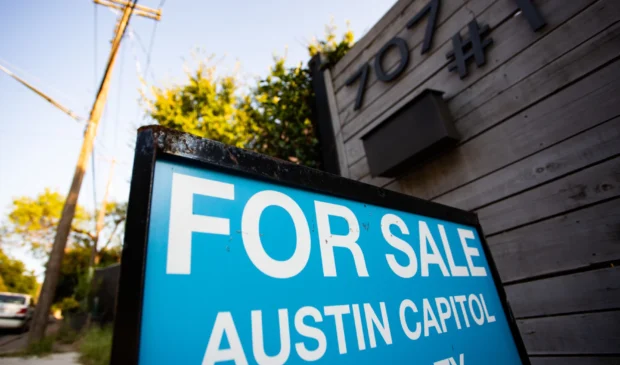Photo by Gabriel C. Pérez/KUT
Austin has a high rate of segregation between homeowners and renters, study finds
Tuesday, June 25, 2024 by
Audrey McGlinchy, KUT Renters and homeowners in the Austin metro live more sequestered from each other than in other U.S. cities, according to a study from Harvard University released last week.
The Austin area has one of the highest levels of renter and homeowner segregation, researchers with Harvard’s Joint Center for Housing Studies found after analyzing U.S. Census Bureau estimates.
One of the reasons for this is a high percentage of what researchers call “rental deserts,” or neighborhoods where fewer than one in five homes are rented or available for rent. A third of neighborhoods in the Austin metro are “rental deserts,” according to researchers’ analysis of data. Researchers found it was most common to find few rented homes in urban neighborhoods west of MoPac Expressway and in the suburbs surrounding the city.
“We were wondering what was shaping all of this geography,” said Magda Maaoui, a postdoctoral fellow with Harvard and one of the study’s co-authors.
Maaoui and her colleagues posited that zoning, or the rules cities and towns adopt that dictate what can be built and where, may be one reason why some neighborhoods have relatively few rental homes.
“(M)unicipalities that allow greater maximum heights and have more zones that allow multifamily housing by right are also home to neighborhoods with a higher share of rental housing as compared to more restrictive municipalities,” they write.
In other words, if a city makes it easier for developers to build typical kinds of rental homes, like apartments, there will be more rental homes. For decades, land use rules in Austin have made it difficult to build anything other than one home with a big backyard or a large apartment complex – and often these buildings are not permitted to be near one another.
“If you’ve worked on zoning and if you’ve worked on things like land use, you look at (this study) and it makes a lot of sense,” said Awais Azhar, deputy director at HousingWorks Austin. “These are the patterns we would expect.”
Maaoui and her colleagues also found that where there was segregation between homeowners and renters, other types of segregation followed, such as economic segregation.
This makes sense: Lower-income people tend to be renters. Buying a home often requires a significant cash down payment, a good credit score and income requirements. Researchers found that the Austin area had a high rate of income segregation compared to other populous cities in the country.
“Racial segregation and the concentration of poverty can feel like intractable problems that we don’t know how to solve,” Maaoui said. “But the absence of rental housing is a problem with an obvious solution.”
Elected officials in Austin have begun to untangle some city rules that make it hard to build anything more than a single-family home with a large backyard. In May, City Council members voted to greatly reduce the amount of land needed to build one home, dropping it from 5,750 square feet to 1,800 square feet. They also have made it possible to build more homes on one piece of land.
This story was produced as part of the Austin Monitor’s reporting partnership with KUT.
The Austin Monitor’s work is made possible by donations from the community. Though our reporting covers donors from time to time, we are careful to keep business and editorial efforts separate while maintaining transparency. A complete list of donors is available here, and our code of ethics is explained here.
You're a community leader
And we’re honored you look to us for serious, in-depth news. You know a strong community needs local and dedicated watchdog reporting. We’re here for you and that won’t change. Now will you take the powerful next step and support our nonprofit news organization?






